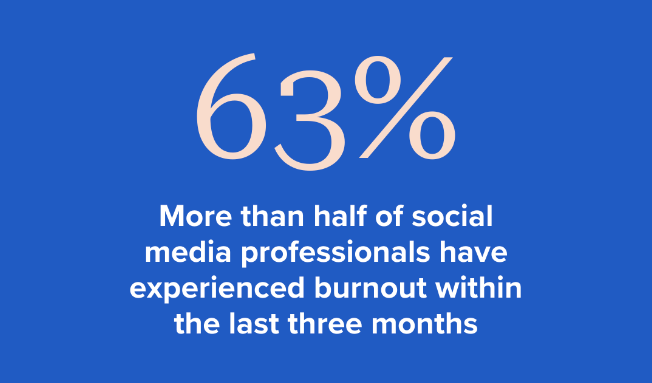Have you ever woken up in a blind panic because there’s a campaign going live tomorrow, and you forgot to schedule a post? Or logged onto Instagram while eating your dinner to check the engagement on your latest Reel?
For social media managers, being “always on” has long been a challenge of the job.
But the appeal of being glued to a screen 24/7 is clearly fading. Sprout research found almost two-thirds of social media professionals had experienced burnout in the previous three months, while two-fifths planned to quit working in social media within the next two years.
Add to this the often negative nature of social media and the fact that much of what happens online is out of your control, and it’s easy to see how the role can take a toll on your mental health.
If all that sounds familiar, you’re in the right place because we will share tactics to help you avoid burnout as a social media manager.
1. Leverage Resources and Support To Help With Stress
We all feel stressed every once in a while. But left unchecked, it can quickly lead to burnout.
Fortunately, there’s no shortage of resources designed to help you deal better with workplace stress. We’ve rounded up some of the most helpful:
- Stress management — The American Institute of Stress
- Coping with stress at work — The American Psychological Association
- How to Recover from Work Stress, According to Science — Harvard Business Review
- How to handle stress at work — Harvard Health
- The secrets to managing work stress like a boss — Calm
At the same time, it’s important to remember that you’re not in this alone. If you’re feeling stressed and burned out, don’t be afraid to tell your manager. They can help you devise strategies to ease your workload, better organize your time, and prioritize the right tasks so you’re not constantly playing catch-up or putting out fires.
It’s also important to draw clear boundaries between work and downtime, particularly for office-based employees. According to HootSuite, two-thirds of social media managers work 40+ hours per week, and those who work full-time in the office are more likely to feel dissatisfied about their work-life balance.
The worse your work-life balance, the more likely you are to experience burnout, so do your best to stop responding to emails and checking your work social accounts when you’ve logged off for the day. And if you find your professional life increasingly creeping into your personal time, speak to leadership to find ways to reduce the burden.
2. Effectively Manage Your Time
Time management is about finding the most efficient path through your working day, helping you get more done faster and with less stress. Consider these time management best practices:
Identify How You Use Your Time
The first step to making better use of your time is to figure out where you’re spending it currently, giving you an insight into common choke points and speed bumps. Over a set period — say, three months — measure what tasks you’re performing and how long each takes using a time-tracking tool like:
At the end of those three months, analyze the data. How much time did you spend on productive tasks, and how much on less valuable actions?
Create Realistic Daily Schedules
Many of us live our working lives by to-do lists. But simply jotting down all the tasks you need to perform at the start of a day doesn’t give us any context for how long each takes to complete.
Human nature dictates that when we face a new project, we invariably underestimate how long it’ll take. This is called the “planning fallacy,” and it often causes us to cram our day with way more work than can be feasibly completed.
Take an outsider’s view when planning your time. Ask yourself: “If a colleague said they could create and schedule a month’s worth of content in an afternoon, would I believe them?” This approach should help you build realistic daily schedules grounded in reality, not blind optimism.
Tackle Tough Tasks First
This one’s simple:
If you’ve got a long or difficult task to accomplish, it’s better to face it first thing in the morning than procrastinate and leave it hanging over you all day. Once you’ve cleared it, everything else you tackle that day will feel like a cinch in comparison!
Stop Juggling Multiple Tasks at Once
At one time or another, we’ve all found ourselves responding to emails while attending a meeting or brainstorming future content ideas while working on a report.
It feels efficient, right?
In reality, the opposite is true: multitasking saps our productivity, making us feel overworked and, ultimately, burned out. Indeed, research published in Computers in Human Behavior found that college students who multitask in class spent longer on homework and had lower GPAs.
It all boils down to the time-related costs of constantly switching your attention from one task to another. Each time you switch, it might take you a few seconds to refocus your energy. In isolation, that doesn’t seem too big of a deal, but multiplied over hundreds or thousands of tasks, it adds up. Plus, swapping back and forth between tasks can increase the risk of errors.
So, if you’re a serial multitasker, now’s the time to ditch the habit.
3. Learn To Rely On Your Co-Workers
Delegation has wide-ranging benefits. Not only does it help the delegator save time, thus reducing their risk of burnout, but it also:
- Creates a culture of trust
- Builds more engaged teams
- Encourages employees to learn new skills
- Stimulates creativity
However, many of us are reluctant to delegate. We may worry about stressing out our colleagues. Perhaps we simply think they won’t do as good a job as us or that it’ll be easier to do the work ourselves.
Whatever the case, those attitudes contribute to burnout. When planning your workload, ask yourself:
- Does this task better fit another team member’s skills or priorities?
- Do you have the time to train someone else to perform the job?
- Could this be a valuable opportunity for a colleague to learn a new skill?
- Is this a lower-impact task that doesn’t require your involvement?
- Do you have enough time to re-do the work if needed?
If you get a lot of “yeses,” chances are this is a task you should delegate.
4. Prioritize Your Workload
An astonishing 82% of workers don’t have a dedicated time management system, relying instead on to-do lists, email inboxes, or simply dealing with whatever feels like the most important task at any given point.
While writing down all your tasks can be helpful, to-do lists can quickly become overwhelming.
Effectively prioritization requires a more considered approach. One of the most popular strategies is to use the Eisenhower Matrix, based on the words of 34th US President Dwight D Eisenhower:
You should prioritize tasks that fall into one of the two “important” categories:
Urgent and Important
Urgent and important tasks require your immediate attention. You can’t avoid them, and the longer you put them off, the more stressed you’ll feel about them — which, in turn, can cause burnout. For example, this might include finishing a critical project with a looming deadline.
Non-Urgent But Important
Meanwhile, important but non-urgent tasks contribute to the long-term success of your team or business. So, while you don’t need to tackle them immediately, you still need to dedicate sufficient resources to them. These tasks could include building stronger links with other teams in your organization or planning a major project that’s not due until the following quarter.
5. Automate Tasks To Free Up Time
While multiple factors can cause burnout, most employees who feel burned out blame their workload, according to research from Eagle Hill Consulting.
So, if you had less work, you’d be less likely to experience burnout.
In a way, this is good news because marketers can automate some social media management-related tasks or at least leverage automation to get tasks done quicker.
Tasks that are ripe for automation typically require a ton of labor-intensive work, happen on a regularly recurring basis, and require the same steps every time they’re performed. Examples include:
- Scheduling social media posts
- Tracking the results of your work
- Curating content for republishing
- Dealing with common customer queries
- Sending follow-up messages
Tools like Buffer, CoSchedule, and Hootsuite allow you to automate that sort of work, freeing you up to focus on more valuable (and interesting) tasks. This results in less burnout.
For more advice, check out our guide: 11 Time-Saving Tools for Small Social Media Teams.
6. Find a Working Method That Keeps You Organized
Eagle Hill Consulting’s research found that time pressures are another major cause of burnout.
A little time pressure is inevitable. Social media is a fast-moving world that’s often highly reliant on external events: something happens, and you must respond quickly.
But some time pressure is avoidable. We’re talking about those hideous times when you’re leading a big meeting first thing in the morning, but you’re running late, haven’t shared the agenda, and can’t remember your password. Eeeesh.
Finding a working method that keeps you focused and on track is key to mitigating these issues. Try:
- Keeping your desk tidy. According to researchers at DePaul University, a cluttered workspace can negatively affect your mental health and productivity.
- Using a task management tool. Platforms like Asana, Notion, and Trello help visualize your priorities and keep you on track.
- Assigning consistent file names. Over half of US office workers say they spend more time searching for documents and files than responding to emails and messages. Make your life easier by creating standard naming conventions for your files and storing them in logically organized folders.
Are you interested in discovering more strategies for success as a social media manager? Sign up for one of our upcoming social media conferences.
Featured image by Pixabay.














